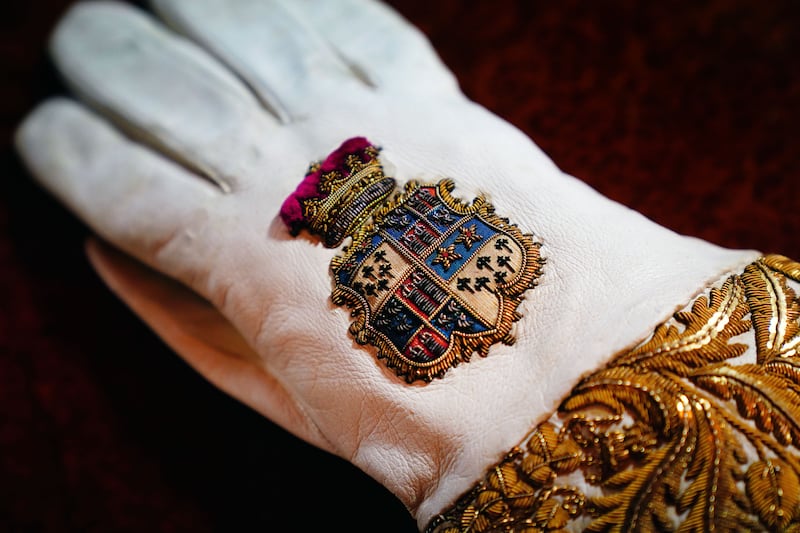Confirmation of the attendance of Sinn Féin vice-president, Michelle O’Neill, at the coronation of King Charles and the inclusion in the ceremony’s running order of a prayer in the Irish language have added some extra, green-tinged intrigue to this week’s events.
Yet the British establishment, including its monarchy and nobility, has always retained official links to Ireland. It may be 101 years since independence and 74 years since the declaration of the Republic, but you wouldn’t always know it from a stroll around the halls of British power.
One thing likely to strike any citizen of Ireland as curious while visiting the Palace of Westminster is the proliferation of Irish harps on show. They are painted in murals and carved into walls and decorative sculptures all over the parliamentary estate. “It’s too late to remove them now,” one member of the House of Lords chuckled to me recently. The entire palace is now a Unesco world heritage site.
The main reason for the emblem’s continued presence all over Britain’s houses of parliament, as well as government departments such as the Foreign Office, is that a golden harp on a blue background to represent Ireland remains a part of the royal coat of arms. This did not change when Ireland achieved independence. The Irish harp is, for example, noticeable above the sovereign’s throne in the House of Lords and it is also embroidered into its cushions.
RM Block
Prior to the accession in 1952 of Charles’s mother, Queen Elizabeth, part of the outline of the Irish harp on the royal arms incorporated a winged, bare-breasted woman, looking almost exactly the same as Ryanair’s blue and gold logo. The queen wanted the topless woman removed, so the arms now includes a simple Gaelic harp instead.
[ God, swerve the king: rock’n’roll proclaims independence from the royalsOpens in new window ]
The bare-breasted harp-woman remains part of the royal standard, the flag that is flown above a British palace whenever the sovereign is in residence. Meanwhile, the sovereign still travels to the Palace of Westminster to open sessions of parliament in the Irish State Coach, which was built in Dublin more than 100 years ago.
Four stained glass windows sit atop the entrances to the four corridors that converge in the iconic central lobby of the Palace of Westminster – one of St George for England, St David for Wales, St Andrew for Scotland and St Patrick for Ireland. As well as the Republic, Patrick is also the patron saint of Northern Ireland, which makes the stained glass window seem less incongruous in Westminster. But even though it was completed after Irish independence in 1923, it still features Patrick standing in front of the Rock of Cashel in Tipperary. He is also flanked by St Brigid and St Columba.

While King Charles has included for the first time the Irish language at his coronation, he appears to have dispensed with other more formal Irish links for his procession into Westminster Abbey. When his mother was coronated in 1953, a member of the House of Lords, the Lord High Steward of Ireland, who was also the Earl of Shrewsbury and Waterford, was part of the group of peers who accompanied her regalia including the Sword of State into the Abbey.
When Elizabeth’s father, George VI, was coronated in 1937, the Earl of Cork actually bore the blunt-tipped Curtana, also known as the Sword of Mercy, as part of the procession. The Lord High Steward of Ireland has helped to carry the regalia at coronations for centuries.
Overall there remains more than 130 titles in the peerage of Ireland, most of which refer to parts of the Republic
Yet none of the Irish-linked peers are named as part of the procession for Charles this week. In any event, the sitting Lord High Steward of Ireland and Earl of Waterford and Shrewsbury, Charles Chetwynd-Talbot, is currently suspended for nine months from the House of Lords for failing to declare certain financial links.
[ Pomp meets humility as the first portrait of Charles as king is unveiledOpens in new window ]
Several other prominent sitting members of the House of Lords derive their titles from the Republic. Tory peer Patrick Stopford, the Captain of the King’s Bodyguard of the Yeoman of the Guard, is also the Earl of Courtown, which may come as a surprise to some people in the Wexford seaside town. John Boyle, Earl of Cork, and Arthur Gore, Earl of Arran, are also members of the House of Lords.

Other members of the peerage of Ireland who do not sit in the House of Lords are Maurice FitzGerald, the Duke of Leinster and Earl of Kildare and Offaly; Henry Beresford, the Marquess of Waterford; Sebastian Browne, the Marquess of Sligo; and Edmund Pery, the Earl of Limerick.
Overall there remains more than 130 titles in the peerage of Ireland, most of which refer to parts of the Republic. Those nobles’ new king will be coronated on Saturday. The rest of the world, including the Republic, will also be watching on, rapt with curiosity at the spectacle of it all.
[ Don’t dismiss Charles III’s coronation as a trivial spectacleOpens in new window ]
















